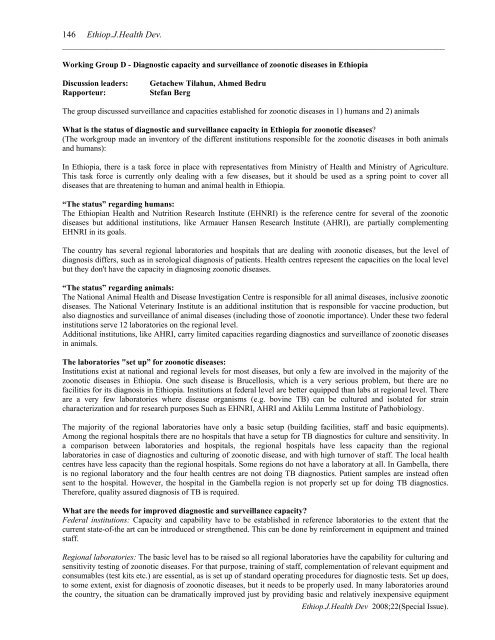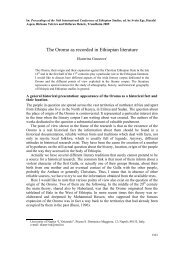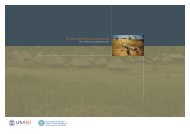You also want an ePaper? Increase the reach of your titles
YUMPU automatically turns print PDFs into web optimized ePapers that Google loves.
146 Ethiop.J.Health Dev.<br />
______________________________________________________________________________________<br />
Working Group D - Diagnostic capacity and surveillance of zoonotic diseases in Ethiopia<br />
Discussion leaders: Getachew Tilahun, Ahmed Bedru<br />
Rapporteur: Stefan Berg<br />
The group discussed surveillance and capacities established for zoonotic diseases in 1) humans and 2) animals<br />
What is the status of diagnostic and surveillance capacity in Ethiopia for zoonotic diseases?<br />
(The workgroup made an inventory of the different institutions responsible for the zoonotic diseases in both animals<br />
and humans):<br />
In Ethiopia, there is a task force in place with representatives from Ministry of Health and Ministry of Agriculture.<br />
This task force is currently only dealing with a few diseases, but it should be used as a spring point to cover all<br />
diseases that are threatening to human and animal health in Ethiopia.<br />
“The status” regarding humans:<br />
The Ethiopian Health and Nutrition Research Institute (EHNRI) is the reference centre for several of the zoonotic<br />
diseases but additional institutions, like Armauer Hansen Research Institute (AHRI), are partially complementing<br />
EHNRI in its goals.<br />
The country has several regional laboratories and hospitals that are dealing with zoonotic diseases, but the level of<br />
diagnosis differs, such as in serological diagnosis of patients. Health centres represent the capacities on the local level<br />
but they don't have the capacity in diagnosing zoonotic diseases.<br />
“The status” regarding animals:<br />
The National Animal Health and Disease Investigation Centre is responsible for all animal diseases, inclusive zoonotic<br />
diseases. The National Veterinary Institute is an additional institution that is responsible for vaccine production, but<br />
also diagnostics and surveillance of animal diseases (including those of zoonotic importance). Under these two federal<br />
institutions serve 12 laboratories on the regional level.<br />
Additional institutions, like AHRI, carry limited capacities regarding diagnostics and surveillance of zoonotic diseases<br />
in animals.<br />
The laboratories "set up” for zoonotic diseases:<br />
Institutions exist at national and regional levels for most diseases, but only a few are involved in the majority of the<br />
zoonotic diseases in Ethiopia. One such disease is Brucellosis, which is a very serious problem, but there are no<br />
facilities for its diagnosis in Ethiopia. Institutions at federal level are better equipped than labs at regional level. There<br />
are a very few laboratories where disease organisms (e.g. bovine TB) can be cultured and isolated for strain<br />
characterization and for research purposes Such as EHNRI, AHRI and Aklilu Lemma Institute of Pathobiology.<br />
The majority of the regional laboratories have only a basic setup (building facilities, staff and basic equipments).<br />
Among the regional hospitals there are no hospitals that have a setup for TB diagnostics for culture and sensitivity. In<br />
a comparison between laboratories and hospitals, the regional hospitals have less capacity than the regional<br />
laboratories in case of diagnostics and culturing of zoonotic disease, and with high turnover of staff. The local health<br />
centres have less capacity than the regional hospitals. Some regions do not have a laboratory at all. In Gambella, there<br />
is no regional laboratory and the four health centres are not doing TB diagnostics. Patient samples are instead often<br />
sent to the hospital. However, the hospital in the Gambella region is not properly set up for doing TB diagnostics.<br />
Therefore, quality assured diagnosis of TB is required.<br />
What are the needs for improved diagnostic and surveillance capacity?<br />
Federal institutions: Capacity and capability have to be established in reference laboratories to the extent that the<br />
current state-of-the art can be introduced or strengthened. This can be done by reinforcement in equipment and trained<br />
staff.<br />
Regional laboratories: The basic level has to be raised so all regional laboratories have the capability for culturing and<br />
sensitivity testing of zoonotic diseases. For that purpose, training of staff, complementation of relevant equipment and<br />
consumables (test kits etc.) are essential, as is set up of standard operating procedures for diagnostic tests. Set up does,<br />
to some extent, exist for diagnosis of zoonotic diseases, but it needs to be properly used. In many laboratories around<br />
the country, the situation can be dramatically improved just by providing basic and relatively inexpensive equipment<br />
Ethiop.J.Health Dev <strong>2008</strong>;22(Special Issue).







